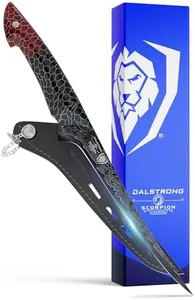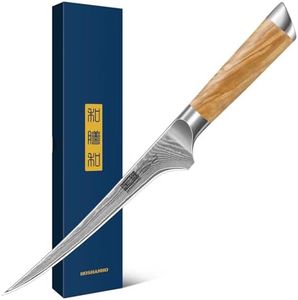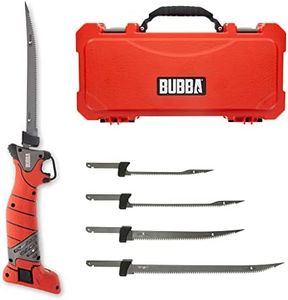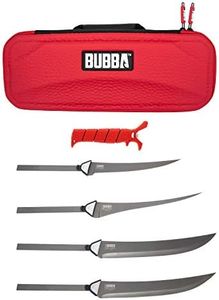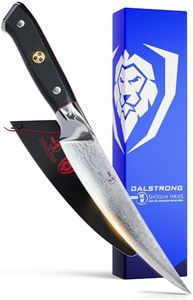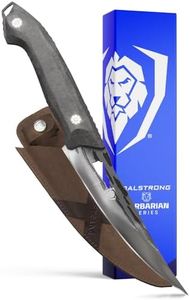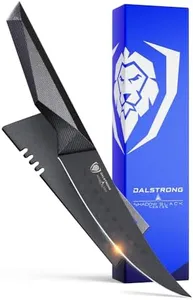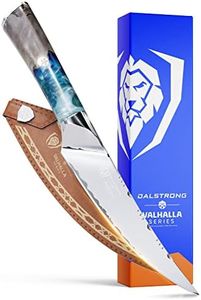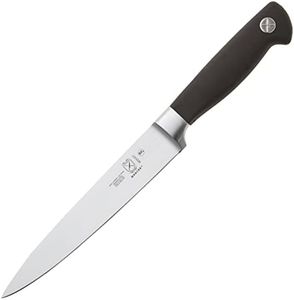10 Best Fillet Knives 2025 in the United States
Our technology thoroughly searches through the online shopping world, reviewing hundreds of sites. We then process and analyze this information, updating in real-time to bring you the latest top-rated products. This way, you always get the best and most current options available.

Our Top Picks
Winner
Dalstrong Fillet Knife - 7 inch - Scorpion Series - Exclusive Japanese V12 Ultra™ Steel - Black Damascus - Black & Red Honeycomb Resin Handle Cooking Boning Knife Gift - Custom-Fit Leather Sheath
Most important from
164 reviews
The Dalstrong Scorpion Series 7-inch fillet knife features a flexible, narrow blade designed for smooth and precise filleting of fish and meat. Its proprietary Japanese V12 Ultra steel core provides excellent edge retention, durability, and corrosion resistance, ensuring the blade stays sharp longer and handles moisture well. The 7-inch length offers a versatile size that balances control and maneuverability for most filleting tasks, while the blade’s flexibility allows it to glide easily under skin and around bones, improving efficiency and reducing effort.
The blade is also finished with an attractive black Damascus pattern, adding an aesthetic touch. The handle, constructed from lightweight resin and aluminum mesh, is designed for comfort and balance, helping reduce wrist fatigue during extended use. Its downward arch and full tang construction contribute to a secure grip and durability. Weighing 1.17 pounds, the knife may feel slightly heavier compared to some other fillet knives, which could be noticeable during longer preparation sessions. The knife is not dishwasher safe, requiring careful hand washing and maintenance to preserve its quality.
A custom leather sheath is included for safe storage and transport, reflecting thoughtful design. With a strong 4.7-star rating and backed by a lifetime warranty, this knife is an excellent choice for home cooks and culinary enthusiasts seeking a reliable, sharp, and stylish fillet knife that balances performance with comfort.
Most important from
164 reviews
Dalstrong Fillet Knife - 7 inch Flexible Blade - Gladiator Series Elite - High Carbon German Steel - Black G10 Handle Boning Knife - w/Two Sheaths - Razor Sharp Kitchen Knife Gift - NSF Certified
Most important from
2512 reviews
The Dalstrong Fillet Knife from the Gladiator Series Elite stands out with its high-carbon German steel blade, which ensures durability and sharpness. The 7-inch blade length is versatile, making it suitable for both small and large cutting tasks. The slightly flexible blade design is particularly beneficial for filleting, as it allows for smooth, precise cuts along the contours of bones without damaging the meat.
The knife's hand-polished edge, angled at 16-18 degrees, contributes to its razor-sharp performance, ideal for both professional chefs and home cooks. Additionally, the full-tang construction provides strength and balance, making the knife feel substantial in hand and reducing wrist fatigue during prolonged use. The handle is made of black G10 Garolite, which is known for its durability and resistance to moisture.
The triple-riveted design ensures a secure grip, while the polished finish offers a comfortable and hygienic handling experience, essential for busy kitchen environments. This knife also comes with two sheaths, providing added protection and storage convenience. It is worth noting that the knife is not dishwasher safe, so it requires careful hand washing to maintain its quality. The Dalstrong Fillet Knife is a robust and efficient tool for anyone involved in filleting, especially those who value precision, comfort, and long-lasting quality in their kitchen tools.


